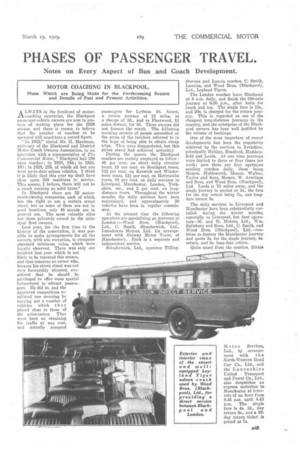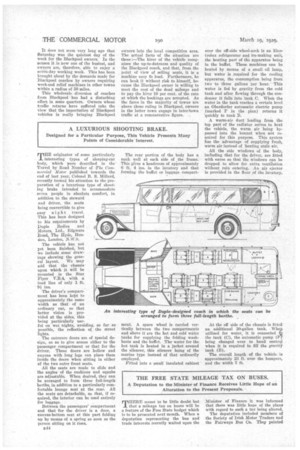PHASES OF PASSENGER TRAVEL.
Page 69

Page 70

If you've noticed an error in this article please click here to report it so we can fix it.
Notes on Every Aspect of Bus and Coach Development.
MOTOR COACHING IN BLACKPOOL.
Plans Which are Being Made for the Forthcoming Season and Details of Past and Present Activities.
ALWAYS in the forefront of motorcoaching enterprise, the Blackpool passenger-vehicle owners are now in process of making plans for the 1929 season, and there is reason to believe that the number of coaches to be operated will censtitute a record figure.
" In 1922," stated Mr. H. Hardman, secretary of the Blackpool and District Motor Coach Owners Association, in an. interview with a representative of The. Commercial Motor, "Blackpool load 156 open coaches; in 1923, 164; in 1924; 163; in 1928, 235, of which all but one were up-to-date 8 al o on vehieles. I think it is likely that this year we "shall have close upon 300 machines in service. This season, I believe, there will not be a coach running on send tyres."
In Blackpool there are 52 motorcoach-owning companies, each of which has the right to use a certain street stand, but as some of them are not in good locations, only 48 stands are in general use. The most valuable sites are those privately owned by the principal fleet owners.
Last year, for the first time in the history of the association, it, was possible to make arrangements for all the owners, with one exception, to recognize standard minimum rates, which were , loyally observed. There was only one incident last year which is not likely to be repeated this season, and that concerns an owner who,
because his street stand was net very favourably situated, con
sidered that he should be
privileged to offer some special inducement to •attract passen
gers. He did so, and the aggrieved competitors retaliated one morning by turning out a number of vehicles which they placed close to those of the price-cutter. They were bent on obtaining his traffic at any cost, and actually accepted passengers for Lytham St. Anus, a return journey of 12 miles, at a charge of 2d., and to Fleetwood, 15 miles distant, for 3d. These owners did not foresee the result. The following morning crowds of people assembled on the scene of the incident referred to in the hope of being able to obtain cheap trips. They were disappointed, but this street stand had achieved notoriety. During the season the Blackpool coaches are mainly employed as follow : 48 per cent, on short daily circular tours, 15 per cent. on Southport tours, 121 per cent. on Keswick and Windermere tours, 121 per cent. on Morecambe tours, 10 per cent. on daily services to Liverpool, Manchester, London, Yorkshire, etc., and 2 per cent. on longdistance tours. Throughout the winter months the daily services have been maintained, and approximately 20 vehicles have been in regular commission.
At the present time the following operators are specializing on journeys to London :—Wood Bros. (Blackpool), Ltd., C. Smith, •Standerwick, Ltd., Lansdowne Motors, Ltd. (in arrangement with Eniway Motor Tours, of Manchester). Each is a separate and independent service.
Standerwick, Ltd., operates Tilling
Stevens and Lancia. coaches, Q. Smith, Lancias, and Wood Bros. (Blackpool), Ltd., Leyland Tigers.
The London coaches leave Blackpool at 8 a.m. daily, and finish the 240-mile journey at 6.30 p.m., after halts for lunch and tea. The single fare is 15s., and 20s. is charged for the return journey. This is regarded as one of the cheapest long-distance journeys in the country, and the enterprise of the Blackpool owners has been well justified by the volume of bookings.
One of the most important of recent developments has been the popularity achieved by the services to Yorkshire, principally Halifax, Bradford, Huddersfield and Leeds. At one time journeys were limited to three or four times per week ; now there are four operators sending coaches daily, these being Messrs. Holdsworth, Messrs. Walker, Taylor and Sons, Messrs. W. Armitage and Sons, and Wood Bros. (Blackpool), Ltd. Leeds is 75 miles away, and the single journey is quoted at 5s., the fare for the day return being 7s., and longdate return Ss.
The daily services to Liverpool and Manchester have been substantially curtailed during the winter months, especially to Liverpool, but four operators—M. and H. Motors, Ltd., Wm. Salisbury and Sons, Ltd., C. Smith, and Wood Bras, (Blackpool), Ltd.—continue to feature the Manchester journey and quote 3s. for the single journey, 4s. return, and 5s. long-date return.
Quite -apart from the coaches, Ribble
It does not seem very bug ago that Saturday was the quietest day of the week for the Blackpool owners. In the season it is now one of the busiest, and owners are, therefore, able to enjoy a seven-day working week. This has been brought about by the demands made for Blackpool coaches by owners requiring week-end relief machines in other towns 'within a radius of 50 miles.
This wholesale diversion of coaches from Blackpool has had a disturbing effect in some quarters. Owners whose traffic returns have suffered take the view that the importation of Blackpool vehicles is really bringing Blackpool owners into the local competitive area. The actual facts of the situation are these :—The hirer of the vehicle recognizes the up-to-dateness and quality of the Blackpool coach, and that, from the Point of view of selling seats, it is a machine easy to load. Furthermore, he can book it without risk to himself, because the Blackpool owner is willing to meet the cost of the dead mileage and to pay the hirer 10 per cent, of the rate at which the bookings are accepted. As the fares in the majority of towns are above those ruling in 731aekpool, owners in the latter town engage in inter-town traffic at a remunerative figure.




















































































































